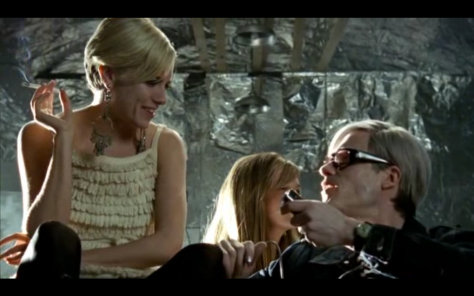By Dennis Hartley
(Originally posted on Digby’s Hullabaloo on August 18, 2007)

(This review is based on the “extended” director’s cut of the film that appears on the DVD; I have not screened the original theatrical version.)
One of the more interesting trends to emerge with the narrowing window between the moment a first-run film leaves the multiplex and its DVD release is what I like to call the “auto repair cut” of box-office flops (“OK, I think I’ve found the problem -try starting it now.”)
Consider George Hickenlooper’s extended cut of Factory Girl, his biopic about the pin-up girl of the 1960s underground, Andy Warhol discovery Edie Sedgwick. Plagued by production problems and prematurely rushed into theaters late last year, the film did marginal box office, and was even less enthusiastically received by some of the surviving real-life participants in the Warhol Factory scene
Edie Sedgwick was the Paris Hilton of the 1960s; a trust fund babe imbued with no discernible talent aside from the ability to attract the paparazzi by associating with the right people at just the right places at just the right time. Despite growing up as a child of privilege, Sedgwick’s childhood was less than idyllic (two of her brothers committed suicide and her mother was institutionalized).
She arrived in NYC in the mid 60s and was drawn to the downtown art scene, where she was spotted by Warhol. Taken by herwaif-like beauty, he vowed to make her a “superstar”. He featured her in his experimental films, and she became the iconic symbol of the “Factory”, where Warhol worked on his projects and played host to a co-op of avant-garde artists, musicians, actors and hangers-on.
Sedgwick fell from grace with Warhol when she became strung out on various substances and was financially cut off by her family. She sought treatment and cleaned up, only to tragically die of a drug overdose at age 28.
Hickenlooper’s affection for the subject is evidenced in his canny visual replication of the 60s underground art scene; he alternates grainy, b&w film footage with saturated 16mm color stock and utilizes hand-held cinema verite shots, aping the look of Warhol’s own experimental films. The fashion, the music, and the overall vibe of the era is pretty much captured in a bottle here.
But what about the narrative? Ay, there’s the rub. The director’s pastiche plays like the Cliff’s Notes version of Warhol and Sedgwick’s partnership. A lot of things are left unexplained; peripheral characters come and go without exposition (it wasn’t until the credits rolled that I learned tidbits like “Oh, that was supposed to be Moe Tucker from the Velvet Underground?”
In a narrative film, you can get away with creating bit parts like “Man #2 with suitcase” or “Crazy bag lady in subway”, but when you are dramatizing a true story…well, I think you see my point. (Ironically, the 30 minute documentary extra on the DVD, featuring recollections from friends and family. offers more insight into what made Sedgwick tick than the full length feature does).
You can’t fault the actors. Sienna Miller gives her all in the lead role and does an admirable job portraying the full arc of Edie’s transition from an innocent pixie, fresh from a pastoral country estate, to a haggard junkie, encamped in a dingy room at the Chelsea Hotel.
The always excellent Guy Pearce “becomes” Warhol. It’s not as easy as one might think to convincingly inhabit Warhol’s deadpan persona; actors have made valiant efforts (David Bowie, Jared Harris and Crispin Glover) but generally end up doing little more than donning a white wig and delivering a rote lank stares and signature catch phrases (“Umm, yeah. That’s great.” “Yeah, hi.”).
Even the traditionally wooden Hayden Christensen registers a pulse with his performance and delivers a spirited impression of Bob Dylan. Sorry-did I say ‘Bob Dylan’? I meant to say, ‘Billy Quinn’ (as in “The Mighty Quinn”?), referred to as a “famous folk singer”.
Factory Girl is perhaps not quite as dismal as many have led you to believe, but it is still not as good as one might have hoped.